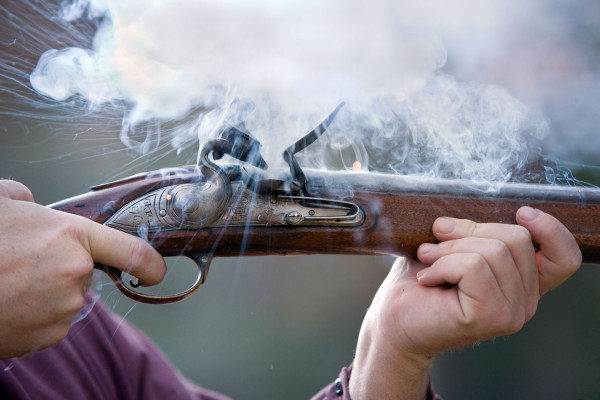
There are hundreds of different ways to visit Colonial Williamsburg. Most guests try to sample a little bit of everything—you can’t do it all even if you live here. But if you’re inclined to a themed tour of the town, and you’re interested in the history and use of firearms, you might enjoy this one-day itinerary tailored to that interest.
Start you journey in the Visitors Center—you’ll need tickets to get into the sites and into the museums.
9 a.m. The Gunsmith
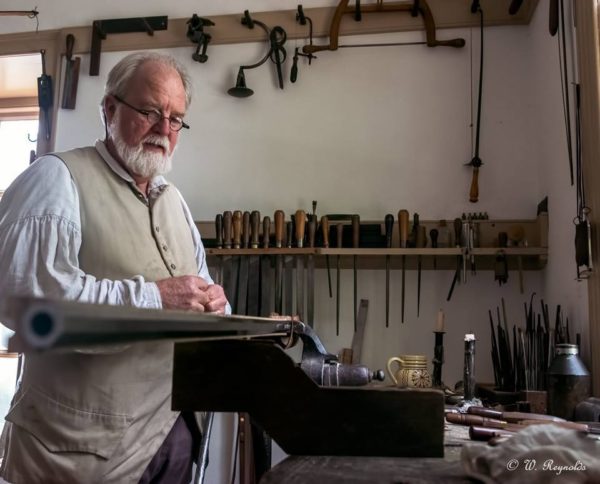
The indispensable stop for anyone interested in firearms is the Gunsmith Shop. To get there, take the shuttle bus from the Visitors Center to the second stop at the Capitol. (This is different from the express shuttle that goes directly to Market Square.) At the circle beyond the Capitol, turn left on Blair St. You’ll find the gunsmiths in the Ayscough Shop on the left just before you get to Francis St.
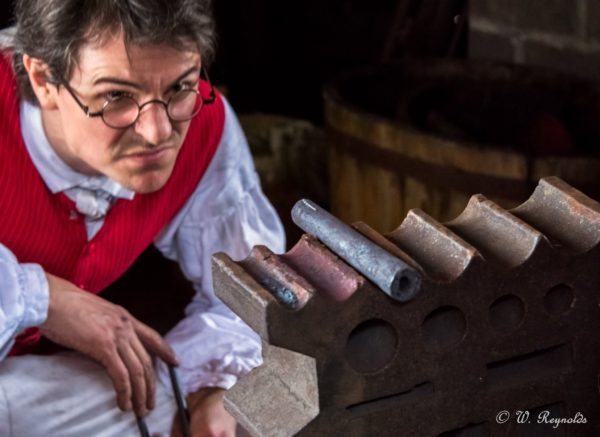
Many people assume that an 18th-century gunsmith would have spent most of his time making weapons for the colonial militia, but that’s not the case. Most would have done a lot of repair work as well as making the occasional civilian rifle. Watch our expert gunsmiths as they build working firearms, many with intricate decoration.
The Gunsmith returned to its former location in the Ayscough Shop in January 2016. It’s open Sunday through Friday, 9-5. Closed Saturday.
10 a.m. The Public Armoury
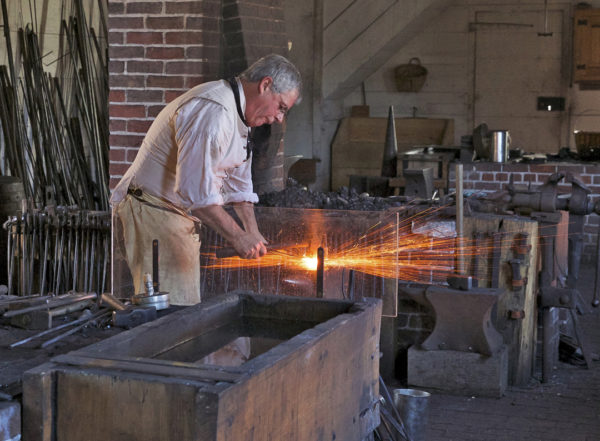
Once you’ve peppered the Gunsmith with all your questions, head back toward the Capitol, then west on Duke of Gloucester St. (You’ll pass right by the Raleigh Tavern Bakery if you need a morning snack!) About a quarter mile down on your left, a brick red sentry box tells you you’re at the entrance for Anderson’s Blacksmith Shop and Public Armoury.
James Anderson was a blacksmith who became Williamsburg’s Public Armourer, meaning he was responsible for making sure that the town’s supply of weapons housed in the Magazine was kept in good working order. When the Revolution began, war mobilization spurred the expansion of Anderson’s business to supply the needs of the military.
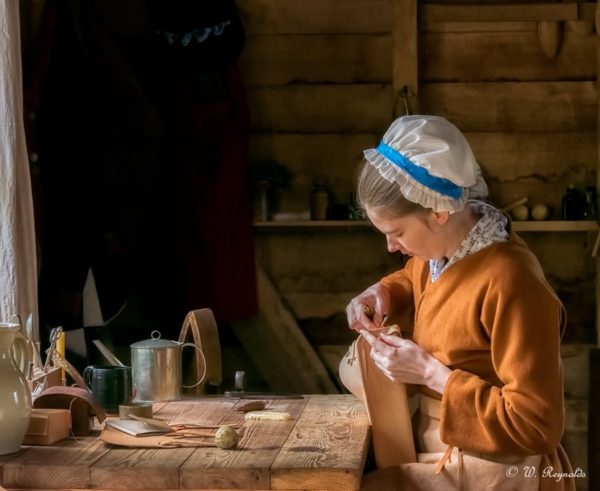
During your visit, don’t overlook the small building behind the Armoury, where the Military Artificers ply their trade. They mainly work with leather goods and ancillary supplies for the army, including some nifty cartridge boxes.
Anderson’s Blacksmith Shop and Public Armoury is open daily, 9 to 5.
10:45 The Military Encampment
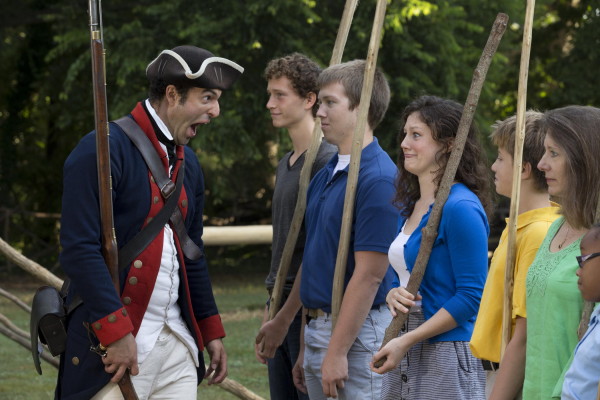
A quick detour north on Botetourt St. will bring you to the Military Encampment. You’re here to receive instruction in the manual of arms from the drill sergeant for the Virginia State Garrison Regiment. Learn how they handled their weapons in the 18th century, and spend a little time learning about the daily life of soldiers. Join in as soldiers and camp followers of the go about the business of preparing food and shelter. You may find a few fifers and drummers providing the camp’s music, too.
The Military Encampment is at the corner of Botetourt and Nicholson St., and is open 10 a.m. to 2 p.m., June 20-Aug. 20.
11:30 a.m. The Magazine
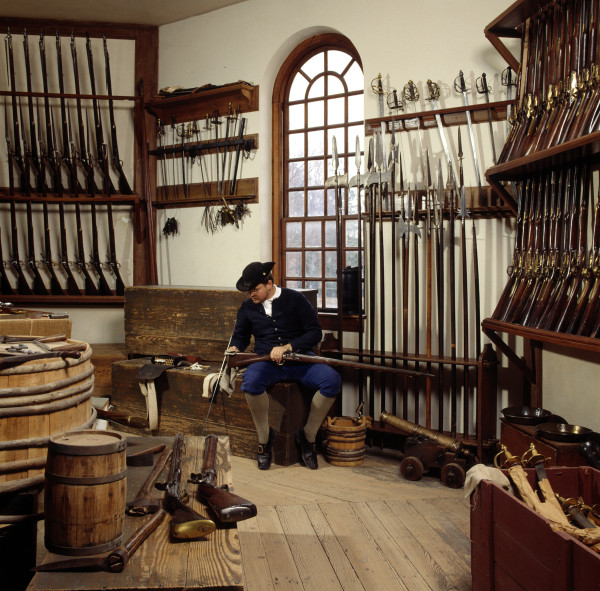
Continuing west on Duke of Gloucester St., you’ll soon reach the iconic octagon where the town’s arms were kept. Lord Dunmore, of course, infamously seized the gunpowder from the building in April 1775, enraging the people of Williamsburg and hastening the end of royal government in Virginia. In the 18th century, the powder would have been kept on the first floor, weapons on the second floor, and other, lighter military supplies on the third (which is not an exhibited space). Today most everything is on the second floor, and it’s quite a variety.
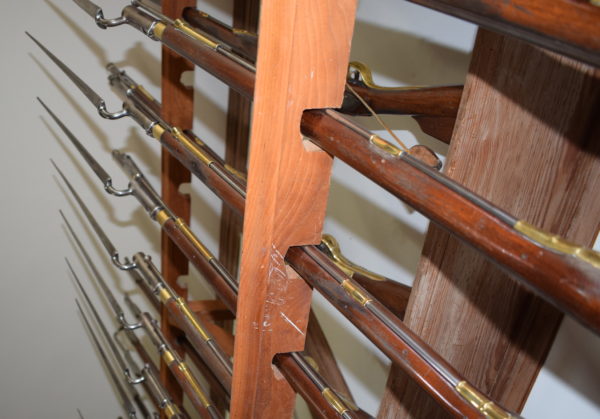
Inside you will discover an amazing collection of the weapons in use in the 18th century. Some are 300 years old. There are examples of military, civilian, and trade muskets-and a few blunderbusses. There are bayonets and swords, canteens and other military supplies. Where else can you compare a small cannon with a Howitzer and a mortar? And on hand there are members of the militia eager to explain how they were loaded, cared for, and used.
The Magazine is open daily from 9 to 4.
11:55 a.m. Firing of the Noon Gun
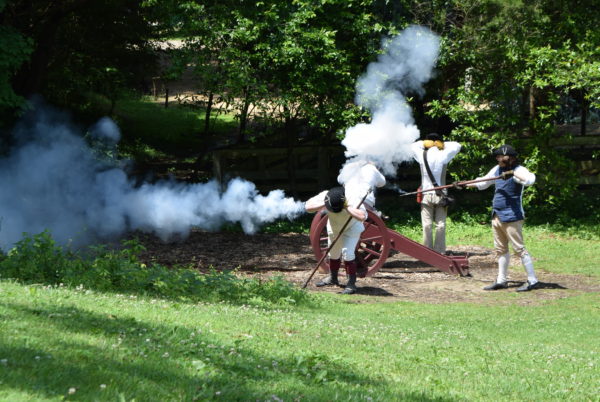
Make sure you tear yourself away from the collection in time for the firing of the noon gun, just outside in the Magazine Yard. This brief program recreates the traditional signal in a military camp that morning drills are ending and it’s time to eat. The “gun” is a three-pound cannon mounted on a grasshopper carriage, a versatile weapon that could be moved and put to use very quickly on the battlefield.
Weather permitting, Firing of the Noon Gun occurs daily at 11:55 a.m. in the Magazine Yard.
12:30 Lunch!
By now you’ve worked up a pretty good appetite. Luckily, there are several options in the vicinity of the Magazine.
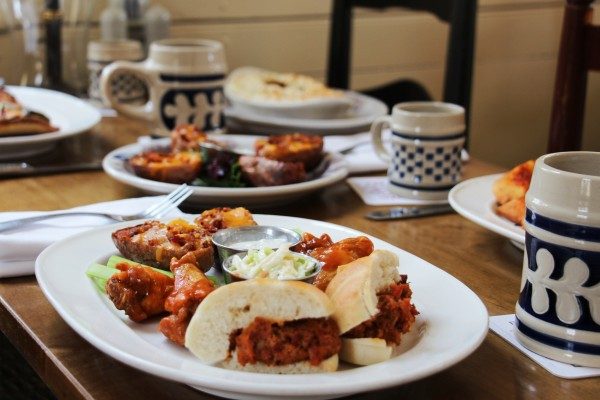
Fresh fruit and nuts are usually in good supply at the Market House next door. A little farther east on Duke of Gloucester St., you can can find an 18th-century style lunch—no reservations necessary—at Chowning’s Tavern. You’ll even find Gunpowder Wings served on the menu.
Several fine restaurants are a few blocks west at Merchants Square. But maybe it’s best to head over to Traditions at the Williamsburg Lodge, because you planned ahead and made a reservation for the Musket Range. A shuttle takes participants from the hotel to the Musket Range.
2 p.m. To Fire a Flintlock Musket
Walk north of the Magazine and cross Francis St. to South England, where the Williamsburg Lodge will be on your right.
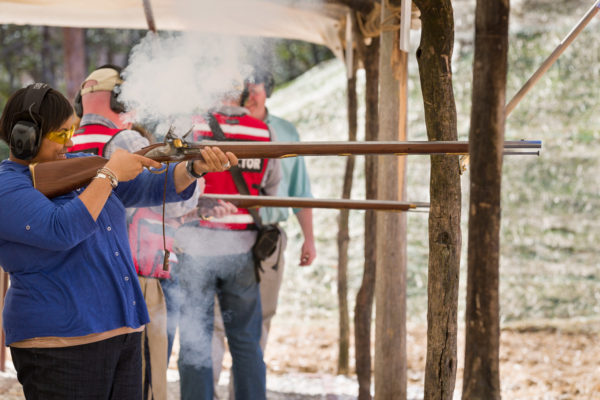
For a true one-of-a-kind experience you have to visit the new Musket Range. The program is called To Fire a Flintlock Musket, and it gives guests the opportunity to get personal training in handling, loading, and firing replica 18th-century firearms. Modern safety rules are enforced, but you get to fire live rounds at a target (plus a souvenir you get to keep) for an hour. And while you’re shooting, ask our expert instructors anything you like about the use of these weapons in colonial times and the Revolution.
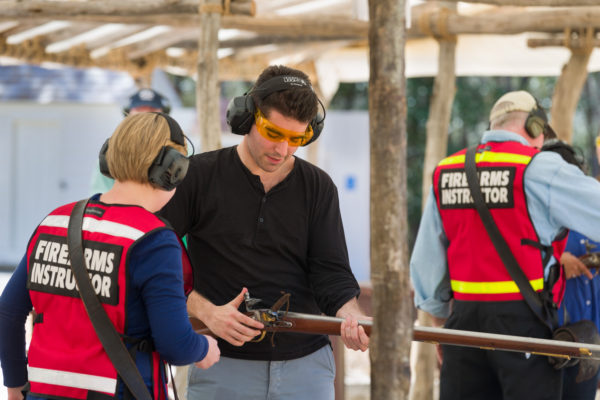
The program is by reservation only, but you can now make your reservations online. Young adults ages 14 to 17 may participate as long as they are accompanied by an adult or legal guardian.
The program To Fire a Flintlock Musket is offered four times daily, weather permitting: 9:45 a.m., 11:15 a.m., 12:45 p.m., and 2:15 p.m. You will need to print out your confirmation letter and bring it to the ticket window in the Williamsburg Lodge lobby at least 15 minutes before your reservation time. At that time you need to present a current and valid photo ID and sign a waiver. The cost is $119 per person.
3:30 p.m. The Wythe House
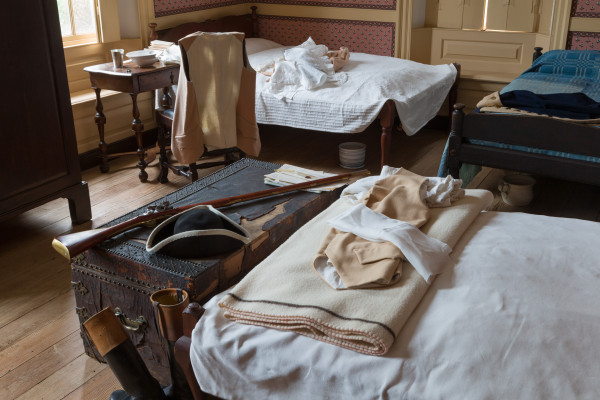
Head south down Palace Green and on the right you’ll find the home of George Wythe, a leading Revolutionary who taught law to Thomas Jefferson and the first chief justice of the Supreme Court, John Marshall. Wythe’s home is arranged to portray the scene in the fall of 1781, when George Washington made it his headquarters as he prepared for the decisive battle in Yorktown.
If you’re visiting next week or after Aug. 21, you might need to squeeze the Wythe House in before lunch. It’s currently open daily 9-1, but beginning Friday, June 17, will have extended summer hours, daily 9-5.
4 p.m. The Governor’s Palace
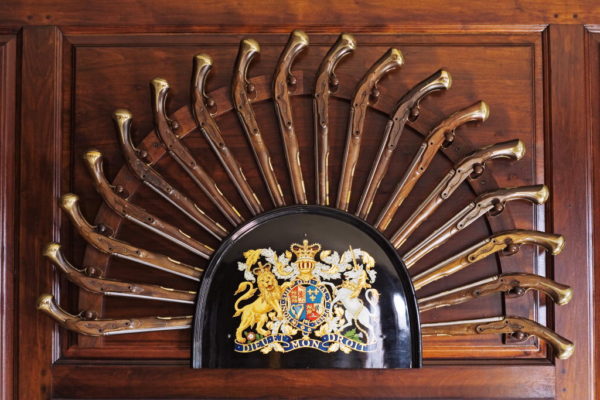
Virginia’s colonial governors displayed their royal authority by displaying hundreds of swords, pistols, and muskets in plain view in the Palace’s entryway and front hall. It’s nicely expressed in the picture above: George III’s crest translates to “God and my right.” Many of the weapons were actually used in the French and Indian War and Dunmore’s War of 1774. If you want to experience the full tour of the Governor’s Palace, try to arrive before the last tour begins at 3:45. But even if you miss that, you can enter after 4 and admire the collection during the last hour of the day.
The Governor’s Palace is open daily 9-5. 25-minute tours begin about every 15 minutes until 3:45. At 4 p.m. guests are free to explore the site at their own pace until closing.
5:00 p.m. On to Yorktown and Victory!
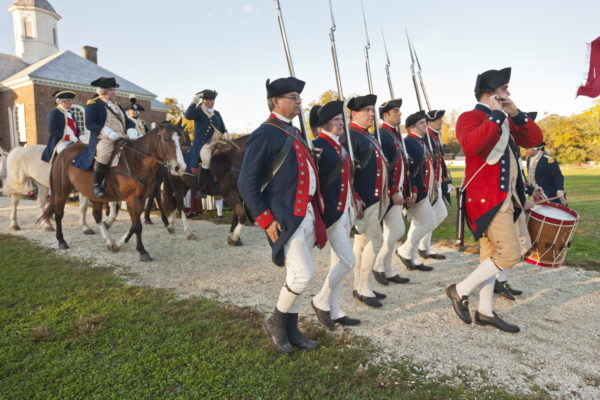
Returning to Market Square across from the Magazine, finish the outdoor portion of your day on a high note with On to Yorktown, where officers review the militia drill, shots are fired, and the fifes and drums play, commemorating the final preparations for the siege on Yorktown that effectively brought the Revolutionary war to a close.
On to Yorktown and Victory! occurs Tues.-Sat. from 5-5:30 p.m. at Market Square.
5:45 p.m. The Art Museums
Take advantage of later operating hours to end your day at the art museums, where ancient firearms coexist quite nicely alongside exquisite portraits, furniture, folk art, and more. Among the wonderful exhibits is Lock, Stock, and Barrel, which offers one of the most extensive displays of British weaponry you’ll ever see, and illustrates the evolution of firearms technology.
The Art Museums of Colonial Williamsburg are open daily 10 a.m. to 7 p.m.
Souvenirs for Gun Enthusiasts
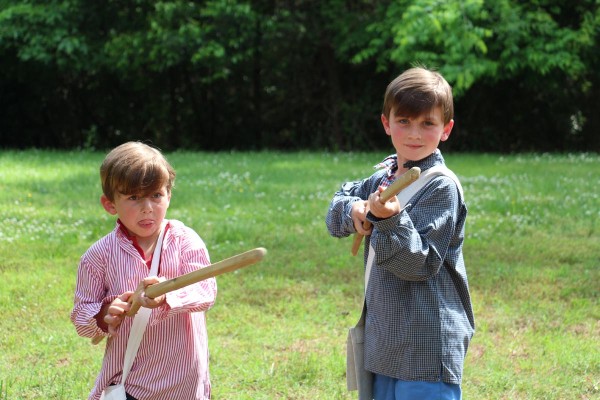
Stop by one of our Historic Area shops as you make your way through town and you’ll find some great ways to remember your visit. For the kids, there are pistols, muskets and wooden drill guns, of course. There are also canteens and cocked hats you can deck out with ribbons and cockades. You might also consider getting a haversack filled with some of the items a soldier might carry: pewter musket balls, flint and steel for starting a fire, and 18th-century playing cards.
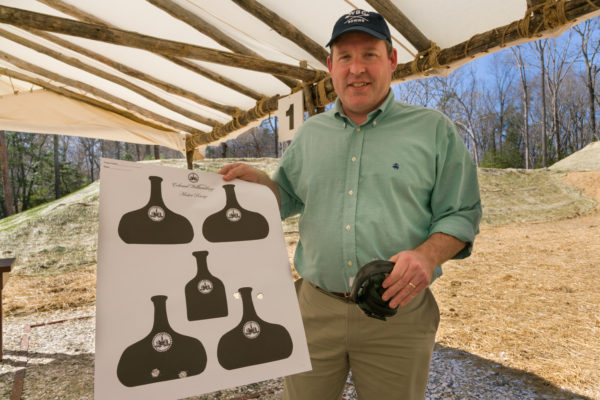
You can purchase the targets used at the Musket Range at the Williamsburg Lodge gift shop.
The Gunsmith of Williamsburg is an hour-long DVD that demonstrates all the steps in making a rifle. It’s available at several shops, including Revolutions at the Visitors Center and Craft House in Merchants Square.
There are countless ways to visit the colonial capital, and the experience is different every time. Feel free to share your own suggestions for customized itineraries. Maybe we’ll feature it next!
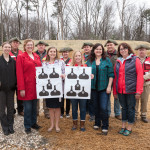

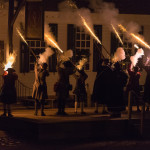
My son and I took advantage of the Musket Range shortly after it opened. Being a frequent visitor to modern gun ranges, I was pleasantly surprised by the quality of this new addition to CW. The range contained high berms in order to keep any errant rounds within the confines of the range. There is always at least one range officer who oversees every aspect of the training, loading and shooting experience. No spectators are allowed at the range. It is important that the range employees focus ALL of their attention on the participants and not in gawkers. There was a lengthy safety course before ever even touching a firearm. Then each participant was given an education on how these antique style firearms work….and what to do when they don’t work, e.g. Misfire. We each fired several rounds with both a musket and a fowling piece. Both firearms gave a healthy report. The experience of firing these early style guns gives one an appreciation for the skill that must have been required to become proficient with them. Overall, the new Musket Range was an excellent experience. I’ll be back for another go at this in the future.
My wife and I are visiting CW July 1 - July 7 and she insists that I take advantage of the opportunity to fire a musket and a fowling piece as I am 68 and it is a once In a life time deal to do so. I have served this great country in the military and have a deep patriotic pride and respect for those brave patriotic men and women whom I emulated with my service to my country.